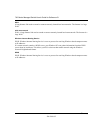
700 Series Managed Switch User’s Guide for Software v2.1
6 Glossary
SM-10004-02
Ranges of addresses are assigned by Internic, an organization formed for this purpose.
IP multicast
Sending data to distributed servers on a multicast backbone. For large amounts of data, IP Multicast is more
efficient than normal Internet transmissions, because the server can broadcast a message to many recipients
simultaneously. Unlike traditional Internet traffic that requires separate connections for each
source-destination pair, IP multicasting allows many recipients to share the same source. This means that
just one set of packets is transmitted for all the destinations.
ISP
Internet service provider.
Internet Protocol
The main internetworking protocol used in the Internet. Used in conjunction with the Transfer Control
Protocol (TCP) to form TCP/IP.
LAN
A communications network serving users within a limited area, such as one floor of a building.
Load balancing
The ability to distribute traffic across various ports of a device, such as a switch, to provide efficient,
optimized traffic throughout the network.
local area network
LAN. A communications network serving users within a limited area, such as one floor of a building.
A LAN typically connects multiple personal computers and shared network devices such as storage and
printers. Although many technologies exist to implement a LAN, Ethernet is the most common for
connecting personal computers.
Loop
An event that occurs when two network devices are connected by more than one path, thereby causing
packets to repeatedly cycle around the network and not reach their destination.
MAC
Media Access Control. A protocol specified by the IEEE for determining which devices have access to a
network at any one time.
MAC address
The Media Access Control address is a unique 48-bit hardware address assigned to every network interface
card. Usually written in the form 01:23:45:67:89:ab.
Mbps
Megabits per second.


















